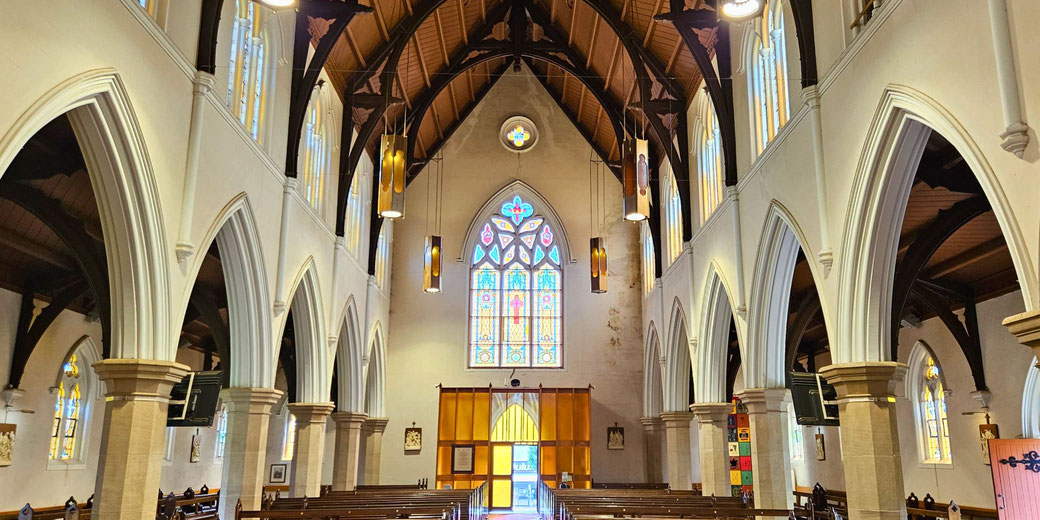How religious belief has changed in Australia over the last 300 years

From the ancient spirituality of its Indigenous peoples to the diverse influx of faiths brought by European settlers, religion has always been a significant factor in Australian society.
When the First Fleet arrived in 1788, Christianity, particularly Anglicanism, became the largest faith group, but this changed as new settlers brought a variety of religious traditions with them.
Unfortunately, this often caused social tensions and conflicts.
Indigenous Australian spirituality
Before the arrival of Europeans settlers, the various Indigenous Australian peoples had spiritual traditions that stretched back tens of thousands of years.
Aboriginal and Torres Strait Islander peoples had beliefs and rituals that were deeply connected to the land.
The most important concept in their faith was the Dreamtime, which explained the creation of the world.
In a variety of Dreamtime stories, ancestral beings like the Rainbow Serpent molded the landscape and established social laws.
Each group had its own ceremonies and rituals that passed these beliefs and practices down through generations.
Indigenous Australian spirituality emphasized the interconnectedness of all things.
This belief system fostered a deep respect for the natural world and its cycles.
Every rock, tree, and waterhole held spiritual significance. As a result, the First Nations peoples of Australia had a totemic system which spiritually linked individuals to specific animals, plants, or natural phenomena.
Also, traditional healers played a crucial role in their communities by the development of knowledge about key medicinal plants and spiritual practices.
Therefore, when needed, people could seek their help with both physical and spiritual ailments.
The arrival of European settlement and Christianity
Early European settlement in Australia began in 1788 with the arrival of the First Fleet at Sydney cove.
These eleven ships carried over a thousand convicts, soldiers, and settlers.
Among them was Reverend Richard Johnson, the colony's first chaplain, who established the foundation of Christianity in Australia.
Even though he was operating with limited resources, he was able to build the first church using wattle and daub.
On February 3, 1793, Johnson held the first Christian service in a church on Australian soil.
For many convicts, religion was thought to offer a source of hope and moral guidance.
Since the first waves of convicts were from England, and the Church of England (also known as the Anglican Church) was the official religion, the faith of the new arrivals was expected to follow it.
Therefore, the Anglican Church was closely tied to the colonial administration, and often guided early moral and social policies in Australia.
However, the gradual arrival of the first Irish convicts, who were Catholics instead of Anglican, meant that they brought their faith and traditions with them.
Father James Dixon, a convict priest, received permission to hold the first Catholic mass in 1803.
However, since the Irish and the English had a long history of conflict, so did the different Christian branches of Catholicism and Anglicanism.
In 1838, Bishop John Bede Polding became the first Catholic bishop of Australia, and he helped to organize the Catholic Church in the expanding colonies.
His leadership saw the establishment of schools and charitable institutions. By the late 19th century, Catholics had become a significant religious group within the colonies.

The religious diversity of the 19th Century
When gold was discovered in Australian in the 1850s, thousands of immigrants from around the world poured into the colonies.
Among these new arrivals were people of various faiths, including Jews, Hindus, and even more kinds of Christian denominations.
In 1835, Reverend John Dunmore Lang brought the first Presbyterian minister to Sydney.
Additionally, the influx of Chinese immigrants during the gold rush brought Buddhism and other Eastern religions to Australia.
The Jewish community also began to establish itself in the 19th century. In 1844, the Great Synagogue in Sydney was founded, which quickly became a central place of worship and community gathering.
Similarly, the Methodist Church grew rapidly during this period. By 1855, the church had established numerous congregations and schools throughout the colonies.
The Methodists had a particular focus on education and social reform. Also, immigrants from Germany brought Lutheranism and, by 1884, the Lutheran Church had built several churches and schools.
With each new wave of immigrants, people of different faith traditions struggled to find a way to peacefully coexist.
Religion and immigration in the 20th Century
After the federation of Australia in 1901, the country was officially considered to be an Anglican nation.
At the time, 99% of the population declared themselves as Christian (40% Anglican, 23% Catholic, and 34% other denominations).
However, after the end of World War II in 1945, Australia launched an ambitious immigration program to boost its population and workforce.
So, between 1945 and 1960, over two million immigrants arrived: mostly from Europe. Among them were Italian and Greek Catholics.
By 1971, Anglicanism had dropped to 31%, while Catholics had increased to 27%.
The 1970s and 1980s saw another wave of immigrants, particularly from Asia. In addition, the end of the White Australia policy in 1973 opened the doors to non-European immigrants.
In that year, Prime Minister Gough Whitlam's government formally adopted ‘multiculturalism’ as a policy, which sought to ensure equal opportunities for all cultural and religious groups.
This saw a major influx of Vietnamese refugees, following the Vietnam War, who brought Buddhism and other religious traditions with them.
As a result, Buddhist temples and cultural centers began to appear. But even by 1991, non-Christian faiths still only accounted for 3% of the Australian population.
For Muslims, the late 20th century was influenced by immigration from Lebanon, Turkey, and later Afghanistan and Iraq.
In 1976, the first mosque in Sydney, the Auburn Gallipoli Mosque, opened its doors.
By the end of the century, Islam had become one of the fastest-growing religions in Australia.

What about people who had no religion?
With each passing year of the 20th century, there was a gradual increase in the number of people who were not part of any organized religion in Australia.
According to the Australian Bureau of Statistics, the number of people identifying as having no religion increased from 6.7% in 1971 to 30.1% in 2016.
This shift was part of larger global trends towards secularism and individualism. In addition, due to the increasing urbanization and higher education levels, Australians began to question traditional religious institutions.
By 1986, the number of Australians attending religious services weekly had dropped to around 20%.
For many young Australians, religion seemed to be less relevant to their daily lives.
Surveys showed that younger generations were less likely to identify with a specific religious tradition.
In 1991, nearly 40% of people aged 18 to 24 identified as having no religion.
Additionally, changing social attitudes towards issues like marriage, sexuality, and gender roles contributed to the decline of organized religion.
Through the 1990s, religious institutions saw dramatic decreases in those who attended weekly services.
Many Australians began to explore alternative spiritual practices outside traditional religious frameworks.
The census data from 2011 showed an increase in people identifying as ‘spiritual but not religious’.
In particular, various New Age beliefs and practices gained popularity during this period.
For the major religious institutions, this change meant that churches faced declining membership and financial difficulties.
In 2001, the Uniting Church reported a 25% decrease in weekly attendance over two decades. Today, Australia remains a largely secular society.
As of 2021, 40% of the population claim to have ‘no religion’, and the total number of Christians falling below 50% for the first time in Australia’s history.
What do you need help with?
Download ready-to-use digital learning resources
Copyright © History Skills 2014-2025.
Contact via email
With the exception of links to external sites, some historical sources and extracts from specific publications, all content on this website is copyrighted by History Skills. This content may not be copied, republished or redistributed without written permission from the website creator. Please use the Contact page to obtain relevant permission.





